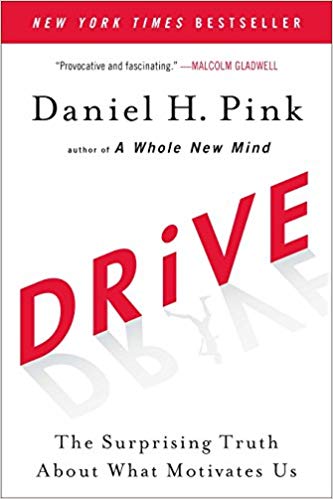Drive is another popular book from the author of best-selling and insightful books such as The Adventures of Johnny Bunko, Free Agent Nation and A Whole New Mind. Subtitled The Surprising Truth About What Motivates Us, Drive rebukes the long-standing belief that, after satisfying biological needs to survive, external rewards and punishments are the most important motivators for humans. Rather, Pink, drawing on four decades of scientific research on motivation, argues that internal, or intrinsic, rewards are the most important for improving performance and deepening satisfaction.
Pink terms the drive to survive as Motivation 1.0, the drive to seek reward and avoid punishment (commonly known as “the carrot and the stick”) as Motivation 2.0, and the need to direct our own lives, to learn and create new things, and to do better by ourselves and the world as Motivation 3.0. He focuses on “the mismatch between what science knows and what business does” and examines what he purports the three elements of true motivation to be: autonomy, mastery, and purpose.
In exploring some of the extensive amount of research on motivation, his thesis is that “organizations still operate from assumptions about human potential and individual performance that are outdated, unexamined, and rooted in folklore more than science.” He argues that organizations continue to pursue practices such as short-term incentive plans and pay-for-performance schemes in the face of mounting evidence that such measures usually don’t work and often do harm.
Motivation 2.0 is based on the premise that the way to improve performance, increase productivity, and encourage excellence is via extrinsic methods that reward the good and punish the bad. At its heart are two simple ideas: rewarding an activity will get you more of it and punishing an activity will get you less of it. However, Pink discusses that many studies, and “real-world” business cases, have shown that, once money is removed as an issue (he states that “The best use of money as a motivator is to pay people enough to take money off the table.”), carrots and sticks can achieve the opposite of their intended aims.
Pink lists the seven reasons (“deadly flaws”) that carrots and sticks don’t work:
- They can extinguish intrinsic motivations
- They can diminish performance
- They can crush creativity
- They can crowd out good behavior
- They can encourage cheating, shortcuts, and unethical behavior
- They can become addictive
- They can foster short-term thinking
In contrast to Motivation 2.0 and its reliance on extrinsic motivators, Motivation 3.0 relies on intrinsic motivation: the desire inside ourselves that propels us to do the work we do and do it well. Motivation 3.0 depends on what Pink calls Type I behavior, which is fueled by intrinsic desires and depends on three “nutrients:” autonomy, mastery, and purpose. Let’s briefly explore all three.
Regarding autonomy, Pink discussed the findings of researchers Edward Deci and Richard Ryan who have written that “Autonomous (think intrinsic) motivation involves behaving with a full sense of volition and choice, whereas controlled (think extrinsic) motivation involves behaving with the experience of pressure and demand toward specific outcomes that comes from forces perceived to be external to the self.” Pink writes that a sense of autonomy has a powerful effect on individual performance – in particular, autonomy over four aspects of work: what people do, when they do it, how they do it, and whom they do it with. However, encouraging autonomy doesn’t mean discouraging accountability.
Pink’s second “nutrient” of intrinsic motivation is mastery: the desire to get better and better at something that matters. He writes that one source of frustration in the workplace is the frequent mismatch between what people must do and what people can do. When what they must do exceeds their capabilities, the result is anxiety. When what they must do falls short of their capabilities, the result is boredom. Pink argues that control leads to compliance, but autonomy leads to engagement, and only engagement can produce mastery. The goal for organizations, from a motivational perspective, therefore, should be to help employees master their jobs by aligning what an employee has to do and what they can (are able to) do.
Finally, Pink discusses that, although autonomy and mastery are essential, for proper balance and context, purpose is also needed. Autonomous employees working toward mastery perform at very high levels; but those who do so in the service of some greater objective can achieve even more. Motivation 2.0 doesn’t recognize purpose as a motivator and neglects a crucial part of who we are. But Motivation 3.0 seeks to reclaim this aspect of the human condition. “Purpose provides activation energy for living” says psychologist Mihaly Csikszentmihalyi.
The central idea of Drive is the mismatch between what science knows and what business does, and Pink contends that “the gap is wide” and “its existence is alarming.” Science shows that the secret to high performance isn’t our biological drive or our reward-and-punishment (carrot-and-stick) drive, but our third drive: our deep-seated desire to direct our own lives (autonomy), to extend and expand our abilities (mastery), and to make a contribution (purpose).

